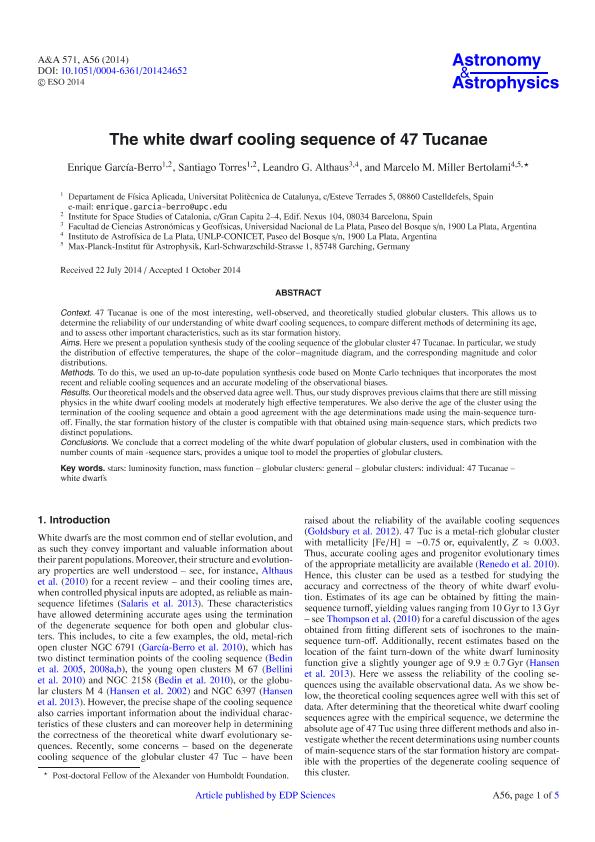Mostrar el registro sencillo del ítem
dc.contributor.author
García Berro, Enrique
dc.contributor.author
Torres, Santiago
dc.contributor.author
Althaus, Leandro Gabriel

dc.contributor.author
Miller Bertolami, Marcelo Miguel

dc.date.available
2017-04-21T14:16:27Z
dc.date.issued
2014-11
dc.identifier.citation
García Berro, Enrique; Torres, Santiago; Althaus, Leandro Gabriel; Miller Bertolami, Marcelo Miguel; The white dwarf cooling sequence of 47 Tucanae; Edp Sciences; Astronomy And Astrophysics; 571; A56; 11-2014; 1-5
dc.identifier.issn
0004-6361
dc.identifier.uri
http://hdl.handle.net/11336/15544
dc.description.abstract
Context. 47 Tucanae is one of the most interesting, well-observed, and theoretically studied globular clusters. This allows us to determine the reliability of our understanding of white dwarf cooling sequences, to compare different methods of determining its age, and to assess other important characteristics, such as its star formation history.
Aims. Here we present a population synthesis study of the cooling sequence of the globular cluster 47 Tucanae. In particular, we study the distribution of effective temperatures, the shape of the color−magnitude diagram, and the corresponding magnitude and color distributions.
Methods. To do this, we used an up-to-date population synthesis code based on Monte Carlo techniques that incorporates the most recent and reliable cooling sequences and an accurate modeling of the observational biases.
Results. Our theoretical models and the observed data agree well. Thus, our study disproves previous claims that there are still missing physics in the white dwarf cooling models at moderately high effective temperatures. We also derive the age of the cluster using the termination of the cooling sequence and obtain a good agreement with the age determinations made using the main-sequence turnoff.
Finally, the star formation history of the cluster is compatible with that obtained using main-sequence stars, which predicts two distinct populations.
Conclusions. We conclude that a correct modeling of the white dwarf population of globular clusters, used in combination with the number counts of main -sequence stars, provides a unique tool to model the properties of globular clusters.
dc.format
application/pdf
dc.language.iso
eng
dc.publisher
Edp Sciences

dc.rights
info:eu-repo/semantics/openAccess
dc.rights.uri
https://creativecommons.org/licenses/by-nc-sa/2.5/ar/
dc.subject
White Dwarfs
dc.subject
Luminosity Function
dc.subject
Mass Function
dc.subject
Globular Clusters
dc.subject
47 Tucanae (Estrellas)
dc.subject.classification
Astronomía

dc.subject.classification
Ciencias Físicas

dc.subject.classification
CIENCIAS NATURALES Y EXACTAS

dc.title
The white dwarf cooling sequence of 47 Tucanae
dc.type
info:eu-repo/semantics/article
dc.type
info:ar-repo/semantics/artículo
dc.type
info:eu-repo/semantics/publishedVersion
dc.date.updated
2017-03-27T15:55:09Z
dc.journal.volume
571
dc.journal.number
A56
dc.journal.pagination
1-5
dc.journal.pais
Francia

dc.journal.ciudad
Paris
dc.description.fil
Fil: García Berro, Enrique. Universidad Politecnica de Catalunya; España. Institute for Space Studies of Catalonia; España
dc.description.fil
Fil: Torres, Santiago. Universidad Politecnica de Catalunya; España. Institute for Space Studies of Catalonia; España
dc.description.fil
Fil: Althaus, Leandro Gabriel. Universidad Nacional de la Plata. Facultad de Ciencias Astronómicas y Geofísicas; Argentina. Consejo Nacional de Investigaciones Científicas y Técnicas. Centro Científico Tecnológico Conicet - La Plata. Instituto de Astrofísica La Plata. Universidad Nacional de La Plata. Facultad de Ciencias Astronómicas y Geofísicas. Instituto de Astrofísica la Plata; Argentina
dc.description.fil
Fil: Miller Bertolami, Marcelo Miguel. Consejo Nacional de Investigaciones Científicas y Técnicas. Centro Científico Tecnológico Conicet - La Plata. Instituto de Astrofísica La Plata. Universidad Nacional de La Plata. Facultad de Ciencias Astronómicas y Geofísicas. Instituto de Astrofísica la Plata; Argentina. Gobierno de la Republica Federal de Alemania. Max Planck Institut Fur Strahlenchemie; Alemania
dc.journal.title
Astronomy And Astrophysics

dc.relation.alternativeid
info:eu-repo/semantics/altIdentifier/url/http://www.aanda.org/articles/aa/abs/2014/11/aa24652-14/aa24652-14.html
dc.relation.alternativeid
info:eu-repo/semantics/altIdentifier/doi/http://dx.doi.org/10.1051/0004-6361/201424652
Archivos asociados
